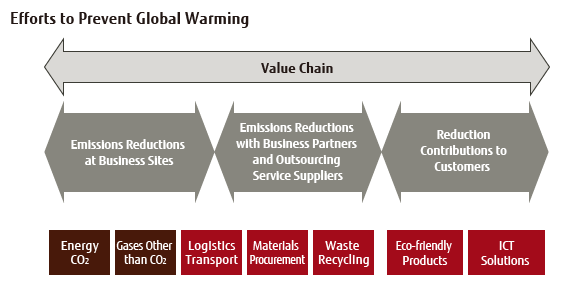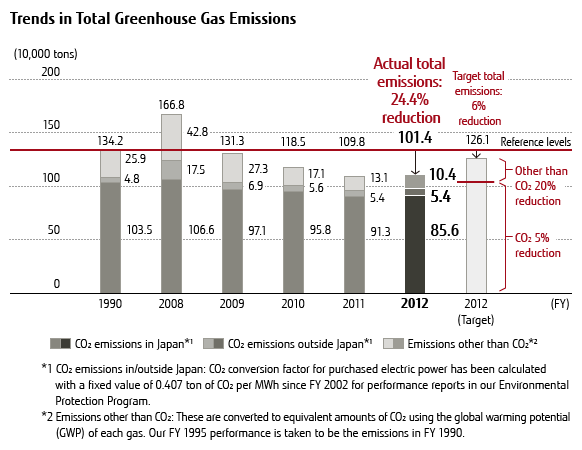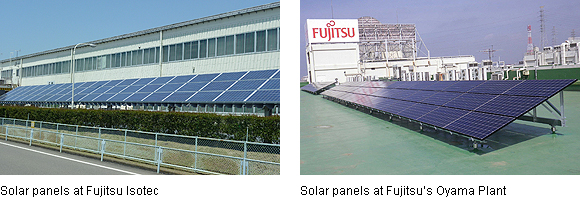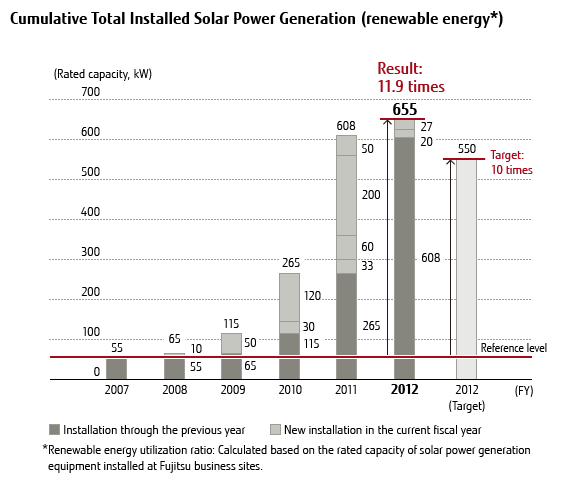Archived content
NOTE: this is an archived page and the content is likely to be out of date.
Efforts to Reduce our Greenhouse Gas Emission
We are examining all of our business operations in an effort to reduce greenhouse gas emissions--not only at our business sites but also in transportation and in the products and services we provide.
Basic Approach
We are working to reduce emissions of greenhouse gases associated with all our Group business activities. These actions include reducing emissions of CO2, due to energy consumption, and other greenhouse gases at business sites (our factories and offices), and reducing emissions associated with transportation.
Furthermore, we are working to prevent global warming throughout all areas of business activity by helping to cut greenhouse gas emissions from our customers and society in general by developing eco-friendly products that contribute to reducing environmental burdens and by providing ICT solutions.

Preventing Global Warming from Business Sites
Greenhouse Gas Emission Reduction Targets and Results
We set "reducing our total greenhouse gas emissions by 6% by the end of FY 2012 compared with FY 1990 (the breakdown for total emissions is a 5% reduction in CO2 due to energy consumption and a 20% reduction in gases other than CO2)" as a goal of the Fujitsu Group Environmental Protection Program (Stage VI).
Our actual total global emissions for FY 2012, the final year covered by the Fujitsu Group Environmental Protection Program (Stage VI), were about 1.014 million tons (per unit of actual sales: 231.4 tons/billion yen), which is a 7.7% or 84 thousand ton reduction from the previous fiscal year, and a 24.4% reduction from FY 1990. At this level, we achieved our target under the Fujitsu Group Environmental Protection Program (Stage VI).

Reduction of CO2 Emissions due to Energy Consumption
CO2 emissions due to energy consumption are responsible for about 90% of the Fujitsu Group's greenhouse gas emissions. Therefore, we continuously work to improve the following energy-saving measures to reduce CO2 emissions.
- Energy-saving equipment, focusing on motive-power facilities (introduction of free cooling, inverters, energy-saving facilities, fuel conversion, etc.)
- Increased efficiencies through revised manufacturing processes, accompanied by proper motive-power facility operation and improvement of management
- Adjusting appropriate room temperature for office air conditioning, saving electricity for lighting and office automation equipment
- Promotion via measurement of energy consumption visualization and proactive use of that data
- Use of renewable energy such as solar power
Further, we set up our Low Carbon Committee at the corporate level in September 2008, establishing reduction targets for each business unit. Stronger measures to achieve these targets follow reforms to processes and equipment (in mounting, assembly and testing) and the development of new technologies. Moreover, our Capital Investment Guidelines define the economic and environmental criteria for investment as we identify and urgently implement priority measures. To address not only CO2 emissions reductions but also the energy supply and demand problems that have arisen following the Great East Japan Earthquake, and do so from a position of greater unity with management, we merged the Low Carbon Committee with the Environmental Management Committee in October 2012.
As a result of actions like those discussed above, our actual energy-consumption CO2 emissions for FY 2012 were about 910 thousand tons (856 thousand tons in Japan, 54 thousand tons outside Japan), which corresponds to a 57 thousand ton reduction from the previous fiscal year and a 15.9% reduction from FY 1990.
![]()
Saving Energy by Shutting Down Datacenter Air Conditioning
Fujitsu's Kawasaki Plant operates a datacenter for internal shared service systems. In FY 2012, we performed a thermal fluid simulation with the ultimate aim of reducing electricity consumed for air conditioning.
This simulation was designed to determine whether shutting down air conditioning equipment would lead to the development of hot spots or an extreme temperature distribution. The most important characteristic of this simulation is that it can provide accurate data for an entire datacenter, which it would be impractical to test while in operation.
Through the simulation performed, it was determined that a total of eight internal datacenter air conditioners - seven during the first half of the year, and one during second half - could be turned off. Based on these results, we turned off air conditioners, took temperature readings, and confirmed that temperatures remained within tolerances. We expect that using fewer air conditioners will cut annual costs by 2.47 million yen and reduced annual CO2 emissions by 83.8 tons.
![]()
Pursuing Energy Savings by Upgrading Lighting Facilities
Completed in August 1986, our Oita Systems Laboratory had been in use for around 25 years and its facilities had deteriorated from age. In FY 2012, therefore, we renovated it. With regard to lighting, in particular, we introduced Hf fluorescent and other high-efficiency fittings because of their longer useful lives and lower energy consumption, and installed a lighting control system enabling the adjustment of the amount of light used.
Once installation work was completed, in August 2012, we began to realize benefits, including a 9,423kWh reduction in monthly electricity consumption, annualized CO2 emissions lowered by 46 tons, and an annualized running cost savings of 1.792 million yen (based on average results through February 2013).
Renovation work also included an upgrade of the air conditioning system, which was completed in May 2013. This investment is expected to produce a 34% savings in electricity consumption, which we aim to verify in the lead-up to summer, when air conditioning will be in greatest demand.
![]()
Saving Energy by Switching to Inverters for Cold and Hot Water Pumps
At the Kyushu R&D Center, we use cold water and hot water created at the plant to cool and heat the entire building. In fact, we use a system referred to as district heating and cooling to heat and cool tenant spaces, computer rooms, and other areas, as well. However, with increased use of personal computers, tenant heat burdens rose and the supply of hot water for heating in the winter became excessive. Furthermore, computer rooms had to be supplied with cold water for cooling even in winter, but pumping capacity, which was enough for the entire building, greatly exceeded this need.
In March 2013, therefore, we installed inverters on the cold and hot water pumps. These inverters made it possible to adjust operation of the cold water pump between 60Hz and 45Hz, and operation of the hot water pump between 60Hz and 30Hz. This ability to adjust pump speeds as needed has reduced our monthly electricity consumption by 32,176kwh, cut annual CO2 emissions by 160 tons (based on 0.407kg CO2/kWh), and slashed annual running cost by 6.55 million yen.
Reducing Emissions of Greenhouse Gases other than CO2
Other than CO2, the Fujitsu Group mainly uses perfluorocarbon (PFC), hydrofluorocarbon (HFC) and sulfur hexafluoride (SF6) in its semiconductor divisions. Following the semiconductor industry's action plan (the Voluntary Action Plan: 10% reduction by the end of FY 2010 compared with FY 1995), we have set a target of a 20% reduction by the end of FY 2012 for the Fujitsu Group Environmental Protection Program (Stage VI). To this end, we have changed to gases with a lower global warming potential (GWP) and continued to install equipment to remove harmful materials in new and existing fabrication lines.
In FY 2012, we reduced the amount of these emissions measured in GWP equivalent by 27 thousand tons, to about 104 thousand tons. This corresponds to a 60.0% reduction compared to FY 1995.
Promoting the Use of Renewable Energy
We have adopted renewable energy sources such as solar power generation at our business sites, in the Fujitsu Group Environmental Protection Program (Stage VI), and we have set increased use of renewable energy as a new goal, and introduced the target of installing ten times as much capacity by the end of FY 2012 as we had in FY 2007.
In FY 2012, Fujitsu Isotec and Fujitsu's Oyama Plant both installed solar panels, the former with a total output of 20kW and the latter, 27kW. With these two additions, our total solar power generation capacity as of the end of FY 2012 had reached 655kW. With this figure at 11.9 times that for FY 2007, we achieved the Fujitsu Group Environmental Protection Program (Stage VI) target.


Responding to the Japanese Revised Energy Conservation Law
As a result of the revisions to and enforcement of the Japanese Energy Conservation Law*1, business operators are now required to grasp their annual energy usage at all their business sites in Japan.
In the Fujitsu Group, we use the FUJITSU Sustainability Solution Eco Track (Fujitsu FIP Corporation) that grasps and tabulates the amount of energy we used across Japan, including for the office space we rent, and manages the amount used by each Group company. Note that the Fujitsu Group includes 26 companies that fall within the class of Specified Business Operators (businesses whose annual energy usage is in excess of 1,500 kl when converted to a crude oil equivalent value) newly stipulated in the revised law.
The amount of energy used by the Group within Japan under the Energy Conservation Law in FY 2012 was 561 thousand kl (crude oil equivalent), corresponding to CO2 emissions of about 1.145 million tons*2 based on the Act on Promotion of Global Warming Countermeasures*3, which was also revised.
*1 Energy Conservation Law:
Act on the Rational Use of Energy.
*2 About 1.145 million tons:
There are differences in ranges for tabulation, which include tenants and calculations based on CO2 conversion factor for each electric power company, for results reporting under our Environmental Protection Program.
*3 Act on Promotion of Global Warming Countermeasures:
A system for calculating, reporting, and disclosing the amount of greenhouse gas emissions stipulated by Japan's Act on Promotion of Global Warming Countermeasures.
Electricity-Saving Initiatives
In preparation for the summer of 2012, businesses served by electric utilities other than the Tokyo Electric Power Company, Incorporated (TEPCO) and Tohoku Electric Power Co., Inc. were asked by the national government to meet quantitative targets (5%-15%) for reducing their electricity usage. In response, the Fujitsu Group's Power Conservation Committee (merged with the Environmental Management Committee from FY2012), chaired by Fujitsu's president, considered objectives and measures for plants and offices in working to set targets in line with government requests. We even went so far as to implement electricity-saving measures to the extent they would not impact operations at business sites served by the Tokyo Electric Power Company, Incorporated (TEPCO) and Tohoku Electric Power Co., Inc., the two utilities for which there were no quantitative target requests.
As a result of the measures taken, business sites served by the Kansai Electric Power Co., Inc. (KEPCO) reduced their electricity consumption during peak periods by a combined 24.4% and those served by the Kyushu Electric Power Co., Inc. reduced theirs by a corresponding 12.2%. Business sites served by other electric utilities also achieved the government-requested targets. Avoiding any impacts on its business activities, the Fujitsu Group continued to implement electricity-saving measures through the winter of 2012.
 Electricity usage display screen
Electricity usage display screen
Saving Electricity with the Environmental Management Dashboard
All of the Fujitsu Group's business sites in Japan have implemented electricity saving measures using the Environmental Management Dashboard. The Environmental Management Dashboard examines electricity usage at each business site hourly, notes differences from targets, makes comparisons to the prior year's actual usage, and factors in weather data from 9:00AM of each day to forecast electricity demand for the day and display it in an easily understood format on the portal screen.
Initiatives at Overseas Business Sites
![]()
Energy Management Project in FTS Augsburg
 Electricity Dash Board
Electricity Dash Board
Fujitsu Technology Solutions GmbH has a development and production site in Germany Augsburg. In September 2012, the FTS Management location Augsburg committed to start the "Energy management project" in order to overcome increasing energy cost and to be an energy efficient factory. An energy management team and the necessary investment were approved.
Firstly we decided to establish energy management system in accordance with ISO50001 since third-party certification of this international standard is supposed to be important for coming EU and German legislation.
As one of requirement from ISO50001, we have defined following targets.
- CO2 emission reduction by 5% from the site in 3 years compared to 2011.
- Energy efficiency improvement by 10% for developed and/or manufactured products as PCs, Monitors, Workstations and Servers, in 2013 compared to 2012.
To realize those targets and accelerate activities, we thought that involvement of each employee was really important and that has been proceeding in 3 steps.
- Collecting ideas to save energy; 385 ideas were collected from employees.
- Implementation of ideas; most relevant ideas were realized concerning lighting, manufacturing or development facility and so on.
- Competition of each department to create new ideas, improve their behavior and save energy (to be realized in 2013)
Concerning electricity consumption, it's possible to confirm our effort through the electricity dash board which visualizes hourly, daily and monthly electricity consumption.
While advancing energy saving activities, we are continuing to develop our energy management systems in terms of energy policy, documentation, performance indicators, and measurement. We will obtain a third-party ISO50001 certification in the near future.
Targets under the Fujitsu Group Environmental Action Plan(Stage VII)
For the Fujitsu Group Environmental Action Plan (Stage VII), we have established the following three targets to be achieved by FY 2015. These targets are based on environmental policies and directions inside and outside Japan, and the Fujitsu Group's business forecasts. Going forward, we will continue to implement, and strengthen, initiatives for achieving these targets.
- Reduce greenhouse gas emissions in our business facilities by 20% compared to 1990.
(Raised to a reduction of 20%, from the 6% target of the Fujitsu Group Environmental Protection Program (Stage VI)) - Improve energy intensity in our business facilities over 1% each year.
(New targets that are consistent with Japan's Revised Energy Conservation Law and the Action Plan of the Industries of Electrical and Electronics on a Low Carbon Society*4) - Increase generation capacity and procurement of renewable energy.
(Move forward with the installation of photovoltaic and other power generation facilities, and the procurement of green electricity and other forms of renewable energy.)
*4 Action Plan of the Industries of Electrical and Electronics on a Low Carbon Society:
An action plan formulated to reduce CO2 emissions in the electrical and electronics industries, based on Nippon Keidanren's Commitment to a Low Carbon Society, a voluntary industry initiative. The plan outlines major initiatives beginning in FY 2013 and establishes energy intensity improvements to be achieved by FY 2020.
GHG Emissions Report based on GHG Protocol Standards*5
| Category | Tons | Notes on Reduction Initiatives |
|---|---|---|
| Purchased goods and services | 1,945,000 | Eco-Friendly Products Reference |
| Capital goods | 19,000 | - |
| Fuel and energy-related activities not included in Scopes 1 and 2 | 79,000 | - |
| Transportation and distribution (Upstream) | Not covered | - |
| Waste generated in operations | 9,000 | - |
| Business travel | Not covered | - |
| Employee commuting | Not covered | - |
| Leased assets (Upstream) | 119,000 | - |
| Category | Tons | Notes on Reduction Initiatives |
|---|---|---|
| Direct emissions | 225,000 | Preventing Global Warming from Business Sites Reference |
| Indirect emissions from energy sources | 790,000 | Preventing Global Warming from Business Sites Reference |
| Category | Tons | Notes on Reduction Initiatives |
|---|---|---|
| Transportation and distribution (Downstream) | "53,000
(Distribution in Japan 25,000 / Distribution overseas 28,000)" |
Environmental Considerations in Transportation Reference |
| Processing of sold products | Not covered | - |
| Use of sold products | 5,083,000 | Eco-Friendly Products Reference |
| End-of-life treatment of sold products | 1,000 | - |
| Leased assets (Downstream) | Not covered | - |
| Franchises | Not covered | - |
| Investment | Not covered | - |
In recent years, there has been a growing movement toward accounting for and reporting greenhouse gas emissions throughout entire supply chains. Applying the Scope 3 international standard established by the GHG Protocol for accounting for and reporting greenhouse gas emissions, the Fujitsu Group, via the Carbon Disclosure Project (CDP)*6, discloses information on greenhouse gas emissions from purchased goods and services, upstream leased assets, transportation and distribution, use of sold products, and end-of-life treatment of sold products.
Moreover, we are proactively engaged in reducing GHG emissions in areas thought to be particularly large sources within the value chain. Examples include energy consumed when products are used, and activities related to raw materials.
Accounting for and reporting Scope 3 GHG emissions in the ICT sector, however, involves many challenges, so Fujitsu is participating in the formulation of the GHG Protocol's ICT sector guidance*7. In the same vein, we have established internal working groups to consider issues related to the reduction of GHG emissions throughout society, including our supply chain. Through these and other initiatives we are actively working to adress GHG-related issues.
*5 GHG Protocol's standards:
Standards formulated by the Greenhouse Gas Protocol, which was established jointly by the World Business Council for Sustainable Development (WBCSD) and World Resources Institute (WRI). The standards set forth approaches for accounting for and reporting emissions by businesses and their value chains.
*6 Carbon Disclosure Project (CDP):
The CDP is a not-for-profit organization in which institutional investors, companies, and others work together to promote the reduction of greenhouse gas emissions and the sustainable use of water resources by encouraging the world's leading companies to account for, and disclose information on, their environmental risk.
*7 ICT sector guidance developed by the GHG Protocol:
GHG Protocol: ICT Sector Guidance![]()
Responding to Climate Change
The Fujitsu Group is not only taking initiatives to reduce GHG emissions; we are also advancing measures to address risks associated with natural disasters and climate change, on a global basis.
![]()
Flood Defenses for a New Plant in Thailand
For three months beginning with July of 2011, Thailand suffered a flood disaster that also caused serious damage to the plant of Transtron (Thailand) Co., Ltd. (TTT), a Fujitsu affiliate. Flood water rose to a level of 3m inside TTT's one-story plant, which housed manufacturing equipment, electrical and other facilities, and finished products waiting for shipment, and caused the company to suddenly suspend its operations. TTT responded to the emergency at hand, and, looking to the future, planned and proposed a new plant that would be safe against the risk of another flood of similar proportions. The proposed design called for the elevation of transformers, the external units of air-conditioning systems, and other facilities to heights at least 5 m above ground level, and the installation of production equipment on the second floor. Furthermore, to protect the entire plant site from floods, the company came up with the idea of building a dyke on the north side of its property. It discussed that idea with the government, which gave its approval. With the March 2013 completion of the new plant and dyke, TTT has now not only secured the safety of its employees but also taken steps that will minimize impacts on its principal manufacturing facilities and products in the event of another major flood in the future.

